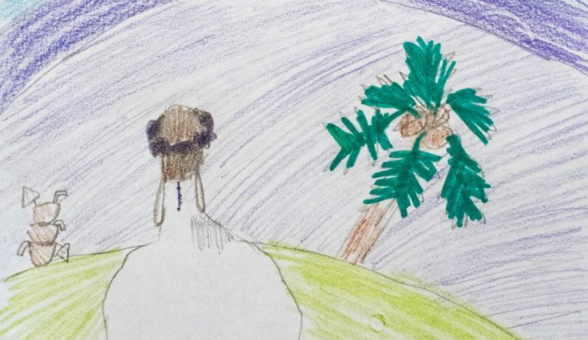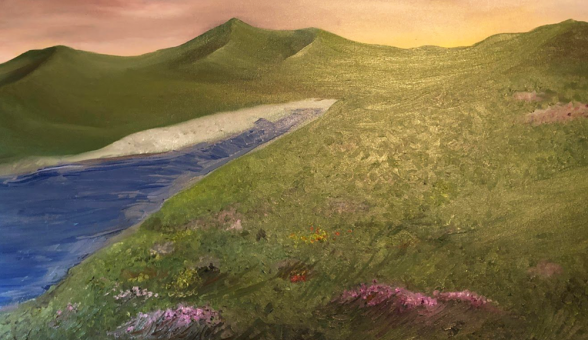Keep It Wild: Earth Day at the BFEC

Rachel Steele (age 8)

April Murphy '22
Love Letters to the Earth
Instead of our Earth Day Festival with live animals, the Brown Family Environmental Center held a contest to see how creative folks could be. We asked people to submit a "Love Letter to the Earth." 17 participants submitted letters. The winners are listed below — click each name to view a PDF of their submission. The text of the letters, if part of the submission, is also available to read on this page.
Children's Division
Rada Ablovatski (age 9), Abigail Steele (age 12) and Rachel Steele (age 8).
Adult Division
Janet Chandler, Jenny Jantzen '23 and April Murphy '22.
Rada Ablovatski (age 9)
Where green grass grows, and the
flowers arose, I live to see where
they could be, a pretty medow, trees
in a row, where is mother nature?
Abigail Steele (age 12)
A poem of Seasons
Fall is a time of Beautiful Leaves,
Pumpkins, Thanks, and Plump Turkeys.
Sweatshirt Weather and Maple Syrup
Oh the Glorious Season of Fall.
Winter brings Sledding, Cocoa and Snow
looking at Icicles from below, Snow
Forts, Snoballs, Snow Galore! Warming
Your hands in Winter.
Spring reminds me of flowers and lambs,
Bonfires, Pies, Blackberry Jam, Blue
Skies or Rain, and all things the same,
I Love Spring.
Summer is hot, but nice in some ways,
Popsicles, Pools, and Cold Lemonade.
Hanging Sheets out on the line,
Soaking up the Warm Sunshine.
Janet Chandler
Letter to the Earth,
Well, Earth, you've done it again. I fell in love with you again. This time, it was the miniscule, mysterious, majestic and magical lichens. Lichens? Yes, lichens. Somehow, in all my years, I've been blind to this ancient and ubiquitous life form. Maybe I was seduced by the grandeur of mountains or the magnificence of a massive white oak or the effervescent song of the wood thrush.
Now, the lichens arrest me. I'm enthralled by their story, for they've been part of you for 400 million years. They are the first life form on rocks, penetrating even granite, beginning the timeless progression of stone to soil. A few lichens might grow as fast as three-quarters of an inch in one year. The Yellow map lichen would take 200 years to grow three-quarters of an inch; but specimens of this lichen have been dated at more than 4,500 years old.
Lichens are connected. They provide food to birds and beasts, from deer to squirrels to snails. They shelter insects. The ruby-throated hummingbirds gather lichen for their nests. They are camouflage for tree frogs. Somehow, they get nutrients from the air, serving also as an indicator of air quality.
Still, I don't understand what this life form is. Its not a plant; it's not an animal. It's different than a fungus. Maybe it's a partnership between fungus and algae or possibly a lichen is an ecosystem. Also, I can't identify most lichens I find in the field. It takes chemistry and a microscope. Thus, I understand little about these life forms and my desire to name and categorize is crushed.
However, I am awed by lichens. I see and live their mystery and magic. Though they may be hard to understand, their subtlety and beauty is not. What artist could sculpt the form or capture the elusive hues. So, once again, I have fallen in love.
Janet Chandler
In celebration of Earth Day, 2020
Jenny Jantzen '23
Dear Mother,
When I was young I would spend my Saturdays writing by a tree with yellow leaves. Her name was Helena, I would chart her growth, press her leaves, ask for permission. From there I'd walk along your arm, mother, until I reached a hill sprouting gravestones above town.
Now I am older, hardly any wiser. I see your branches, your heights, your green-and-orange sadness. The world feels cold. But you write to me still: the forsythia comes in the mail. In town, the blue flowers at my feet erupt into stars. I pick a few, ask for permission.
And sometimes, when you're sleeping, I go out and see Helena. We wrap our arms around each other. We stare down at the sloping earth before us and dream for a while.
Love,
Jenny